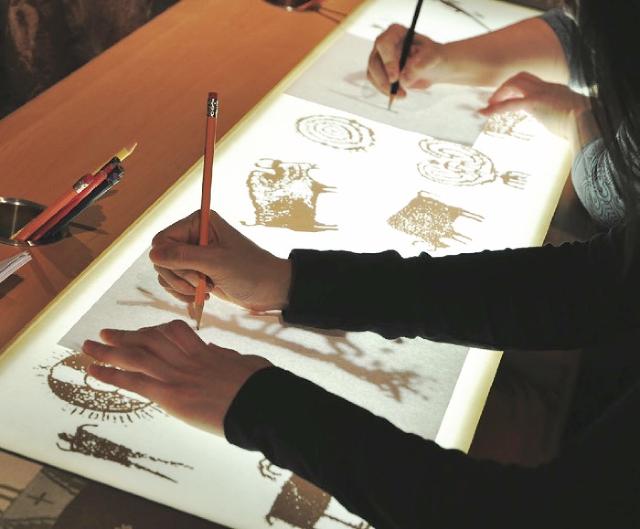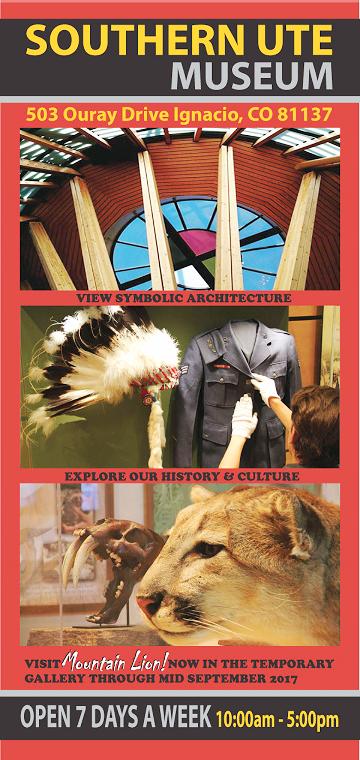 |
Canku Ota
|
 |
|
(Many Paths)
|
||
|
An Online Newsletter
Celebrating Native America
|
||
|
July 2017 - Volume 15
Number 7
|
||
|
|
||
|
Southern Ute Cultural
Center and Museum: Out Of The Garage — Into The Display Case
|
||
|
by Debra Utacia Krol
- Indian Country Today
|
||
|
The Southern
Ute Cultural Center and Museum preserves and showcases Ute culture,
one box at a time
Packed full with cultural motifs in its architecture, with exhibits crafted from tribal member-owned items—occasionally found packed up in garages—and a commitment to education, the Southern Ute Cultural Center and Museum is in the final stages of reinventing itself to tell the story of its community in its own manner. Museum Director Linda Baker, a Southern Ute tribal member, says the center, which first opened its doors in 1971, was once a nonprofit institution with items on loan from across the nation, including the National Museum of the American Indian. "The tribe took the museum over in May 2016," Baker says. After returning all the loaned artifacts, "we started from scratch, and brought out our tribally-owned collections." However, being a community-centered museum doesn't mean an amateur operation: Baker, a seasoned museum consultant, says that one of her tasks has been to ensure a professionally-managed institution.
The Welcome Gallery also is the scene of the cultural center's most striking architectural feature: a timber, steel and glass structure soaring 60 feet into the air in an inverted cone reminiscent of a basket—or a Ute woman's shawl. Supported by huge, straight tree trunks, the breathtaking space is capped with a medicine wheel. Baker says that the frosted glass walls allow dappled light to shine through; oftentimes, she can see the gentle shadows of nearby trees creating a light play as they dance with the breeze. The permanent gallery continues the narrative of Colorado's longest continuous residents using photographic curtains, life-size replicas, video, audio, and touchscreens to keep visitors engaged. A tipi measuring 14 feet in diameter shows how the Numi Nuuchiyu, or Ute People, lived in pre-contact and early contact times. The tribe's radio station, KSUT, has its own display to tell the history of the 40-year-old media outlet. Also on display is a Bear Dance tribute, featuring shawls, gauntlets and the growler, or rasp. There's also a Bear Dance corral outside the museum. Baker notes that the exhibit "Mountain Lion!" currently on display in the temporary gallery through September is especially timely due to the increased interactions between humans and the big cats. Another example of community-contributed items can be seen in the veteran's exhibit, which pays homage to the Ute tradition of protecting their homeland through serving in the military. "There's a diver's helmet there," says Baker. Along with a diving knife, the display comes from a tribal member who retired after a 30-year Navy career. While the museum is open to all, the tribe's cultural department, now housed at the facility, is dedicated to educating the community about its culture and history. The move was part of Southern Ute's plan to transition the cultural center and museum to direct tribal management. Baker says that the cultural center's shift toward more cultural education is reaping results, Baker says, noting that more young people are coming in on their own to experience their culture and history. "We have been seeing young kids coming from as far as an hour away," she says. "One junior high school boy came in with his skateboard—he spent all morning inside looking at the exhibits." In fact, Baker says that it's common for tribal member youth to spend many hours inside the museum. The youth also feel welcomed by the staff. "We've got a great staff here, they are very friendly," Baker says. "They do everything for them but feed them—because no food or drinks are allowed inside!" |
||
|
|
|
|
||
|
|
||
| Canku Ota is a free Newsletter celebrating Native America, its traditions and accomplishments . We do not provide subscriber or visitor names to anyone. Some articles presented in Canku Ota may contain copyright material. We have received appropriate permissions for republishing any articles. Material appearing here is distributed without profit or monetary gain to those who have expressed an interest. This is in accordance with Title 17 U.S.C. Section 107. | ||
|
Canku Ota is a copyright ©
2000 - 2017 of Vicki Williams Barry and Paul Barry.
|
||
 |
 |
|
|
The "Canku
Ota - A Newsletter Celebrating Native America" web site and
its design is the
|
||
|
Copyright ©
1999 - 2017 of Paul C. Barry.
|
||
|
All Rights Reserved.
|
||

 Enter
the Welcome Gallery and see why the
Enter
the Welcome Gallery and see why the